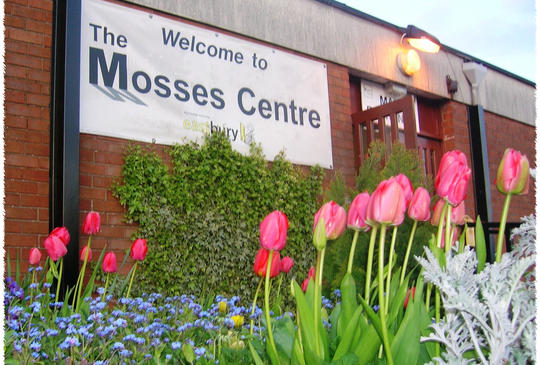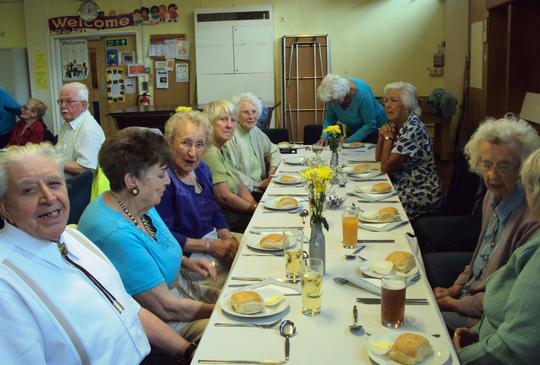
The Mosses Community Association: Managing The Community’s Centre
The Mosses Centre is a large community centre in the Mosses area of Bury, near Bury market and Bury College. Built by the local authority in the early 1970s and run by the Mosses Community Association since 1999, it houses almost forty community groups from across the Borough and several of the Association’s own projects for local residents, including a Pre-School, a Youth Centre and a Café.
Peter Firth is the Chief Officer of the Association and was one of its first employees. I’ve arranged to meet him here, at the Centre, to find out what the Association and community work mean to him and what he thinks are the main challenges. I start by asking him to explain the origins of the Association, what it does now and his role.
The Association was set up, he tells me, because the local authority wanted to shut the Centre down. “Bury Council had had their budget cut”, he explains. “But The Mosses had a lot of user groups and a strong user committee, who wanted to keep the place open. So the committee did a bit of business planning and, to cut a long story short, set up the Association, with a licenced bar company as a trading arm, and negotiated a tapered grant and a peppercorn rent from the Council.”
“That’s when I came in,” he continues. “They advertised two jobs: a full-time Director - as it was then - and a half-time admin and finance person. I was second in command at a community centre in Bolton - the Bolton YMCA. I’d been there for about nine years. I applied for the Director’s job, got it and started in October 1999. After a few years, we became a limited company charity. That’s when my title changed to Chief Officer and the Trustees became Directors.”
Since then, he says, they’ve built up the number of user groups, projects and employees. “We started with the original user groups, a youth project and one-and-a-half members of staff. Now we have about forty different user groups, three of our own projects and fifteen members of staff, including two full-time - the Family Project Officer and me.”

How does he explain their success? The key, he tells me, has been to grow the Centre “gradually and organically”, using their knowledge and experience of the sector to work out what local people and user groups want and then to match that demand with local funding streams.
“When local authorities do surveys”, he explains, “the kids always say, ‘We want more to do’. That’s easy to prove.” What matters, he says, is how you interpret it and respond to it. “Young people don’t just want something to do; they want an identity, whether it is being in a gang in the street or in a football team or in a rock band. That’s what makes them feel happy. So that’s what we try to give them here, in this centre: the opportunity to identify with each other and with the Centre – their centre.”
Changing the attitude of users toward the centre was critical, he argues. “Local authority centres encourage an ‘us-and-them’ mentality. My strap line from the beginning was that this is ‘The Community’s Centre’, not a community centre. When I started here, the older user groups - who had been here when it was a local authority centre - would walk into my office and say, ‘I want to make a complaint,’ as if this wasn’t their centre. It took ages to change that mentality of coming in to get what they could, as cheap as possible.”
Instituting participative governance and infrastructure support has helped, he suggests. “Every quarter we have a Members Forum, where each group has a representative and we discuss matters such as rent, or room rates - rates for them and rates for other community groups and commercial rates, for non-community groups or groups that we don’t support – and fund-raising ideas, including groups doing fund-raising. Only about a quarter of the groups show up, but the process is there.” The Association also supports and advises its members and other user groups on funding and on their constitution, policies and procedures, “setting up accounts or whatever.”
"Young people don’t just want something to do; they want an identity, whether it is being in a gang in the street or in a football team or in a rock band. That’s what makes them feel happy. So that’s what we try to give them here, in this centre: the opportunity to identify with each other and with the Centre – their centre."
The main challenge now is funding. Like a lot of small charities, Peter explains, the Association relies on a combination of grant funding, commissioning and self-generated income. “At the moment roughly half of our income is self-generated and half is from grants – unrestricted core grants (for general running costs, including staff) and grants for particular projects. There’s only been one year when we’ve paid out more than came in. But we are in the same position every year. We need core grants or we’ll go in the red.”
The local authority has been supportive, he says. “They gave us a stepped 3-year core grant when we started - and a peppercorn rent – and then, soon after, a share of the local Single Regeneration Budget. We got a good reputation for delivering what we said we would deliver, which helped us to secure some capital funding from the SRB and, since 2007, when the SRB ended, a three-year rolling grant, on the proviso that they don’t run out of money.”
But, as Peter explains, the Council's support is not enough to keep the Association afloat financially. It still needs to find additional monies from other sources "every year" and more now that the Council's budget has been cut again, which will impact disproportionately hard on its community spend.
And fund-raising is a difficult job, he says; “an art form, not a science, because every funder is different in terms of what they want, how you apply, who decides, that sort of thing. Some funders are friendly, while others are strict – they will provide funding for a fixed number of years or they change the criteria – so we have to be smart about it – do some research and demonstrate that we meet their criteria.”
Networking helps, he says. “Over time you are more likely to get funding if you are at the right meeting, where someone from the council or wherever says they have got funding and ‘have you thought about that’, because they know what work you do.”
It also seems to have helped in changing the broader funding system, he suggests. “I’ve been involved a lot in the Bury infrastructure, building relationships between the third sector and the local authority, in terms of putting the Local Compact together – which makes sure that the local authority treat us with respect – that they don’t pull out of a grant with two minutes notice, for example, and have a fair system for giving out grants to the sector.”
But fund-raising requires resources, and more resources than they’ve got at present. “We pay a guy a little bit to help me with fund raising, but basically it's all done by me."
"Four years ago,” he explains, “our Centre Manager got the job of Chief Officer at another charity in Bury. We didn’t replace her because of the funding constraints at the time. Some of the admin staff took on some of her jobs – such as booking rooms - but I, at the moment, am Chief Officer and Centre Manager. That’s difficult. So the wish list, on top of core funding, is to get funding for a Centre Manager, to free me to do development stuff or whatever.”
The other major challenge is the building. “I don’t think it was built to last,” he says, pointing to the building materials and the build quality.
Part of the challenge is to work with the local authority’s estates team. The Association has got a commercial lease on the building, which, Peter explains, means that the local authority is responsible for the walls and the ceiling, while the Association maintains things like the toilets, the boiler and the cooker. The problem, Peter says, is that the latter can be quite expensive, “especially when they break down”, and the Council “don’t have much money to fix the walls and the roof.”
There is a longer-term plan to improve the space – “to construct a purpose-built childcare centre and a better reception and to get better disabled access and better parking, that kind of stuff”. Peter shows me the drawings. They look fantastic - a centre for community in the community, I think. But, as he points out, it requires funding and it requires fund-raisers.
For further information on The Mosses Community Association and the Mosses Community Centre, go to www.mossescentre.co.uk
This interview is part of Realising the Potential of Community Hubs, a Greater Manchester Local Interaction Platform project.
Contributor Profile
Alex is a Researcher at the Centre for Sustainable Urban and Regional Futures (SURF). He is currently working full-time on the Greater Manchester Local Interaction Platform (GM LIP), one of 5 LIP set up by Mistra Urban Futures, an international centre for sustainable urban futures, based in Gothenburg. His main interest is in the socio-economics of sustainable urban transitions - specifically, the relationship between economic growth and social justice, and the ways in which local authorities engage with local communities.





